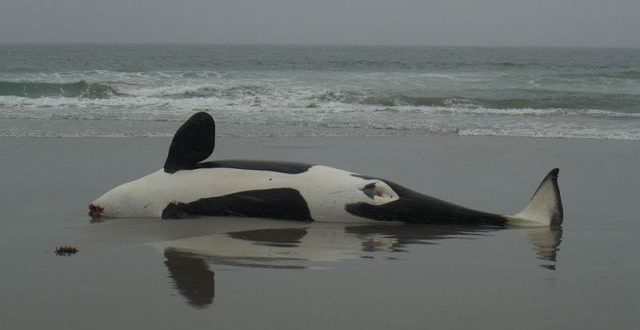Scientists in Scotland believe they’ve found one of the most contaminated killer whales on the planet.
The Scottish Marine Animal Stranding Scheme, managed by SRUC, has found that a killer whale found dead on Tiree had one of the highest levels of polychlorinated biphenyl (PCB) pollution ever recorded.
The adult killer whale – identified as a well-known animal named ‘Lulu’ – died from becoming entangled in creel rope in January 2016, but subsequent analysis undertaken over the past year has shed further light on her case.
Analysis of Lulu’s blubber revealed PCB concentrations 100 times higher than the accepted PCB toxicity threshold for marine mammals. High PCB levels are linked to poor health, impaired immune function, increased susceptibility to cancers and infertility.
Work, undertaken in collaboration with the University of Aberdeen, found that Lulu was at least 20 years old. Based on analysis of the ovaries, it appears that she never reproduced, despite being much older than the average age for maturity in killer whales.
These findings do not bode well for Lulu’s small pod. This small group is usually seen off the west coast of Scotland, and numbers only eight individuals. These individuals never interact with other groups of killer whale, nor has a calf been recorded within the group in the 23 years it has been monitored.
Dr Andrew Brownlow, head of the Scottish Marine Animal Stranding Scheme and veterinary pathologist at SRUC, said: “Previous studies have shown that killer whale populations can have very high PCB burdens, but the levels in this case are some of the highest we’ve ever seen. We know ‘Lulu’ died from becoming entangled, but, given what is known about the toxic effects of PCBs, we have to consider that such a high pollutant burden could have been affecting her health and reproductive fitness.
“Lulu’s apparent infertility is an ominous finding for the long-term survivability of this group; with no new animals being born, it is now looking increasingly likely that this small group will eventually go extinct. One of the factors in this groups’ apparent failure to reproduce could be their high burden of organic pollutants.
“Once PCBs get into the marine environment, they are difficult if not impossible to remove. They accumulate through food webs and persist over time.”
There is a growing concern amongst many cetacean scientists that, unless a much more proactive approach is taken to assessing and decontaminating PCB-contaminated sites to stop these pollutants leaching into the marine environment, then the effects seen with this small group of killer whales on the west of Scotland could become evident in many more of our iconic marine mammal species.
All dead strandings in Scotland should be reported to the Scottish Marine Animal Stranding Scheme (www.strandings.org). The strandings project was set up in 1992, led by SRUC, funded by Marine Scotland and DEFRA. The project aims to collate, analyse and report data for all marine mammals (cetacean and seals), marine turtle and basking shark strandings.
Lulu’s skeleton is preserved at National Museums Scotland.
Agencies/Canadajournal
 Canada Journal – News of the World Articles and videos to bring you the biggest Canadian news stories from across the country every day
Canada Journal – News of the World Articles and videos to bring you the biggest Canadian news stories from across the country every day



